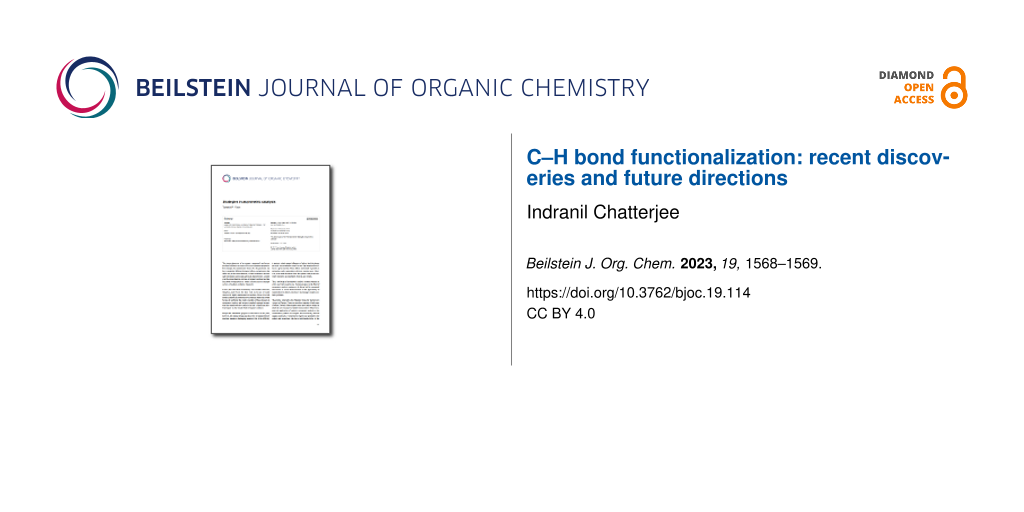The process of C–H bond functionalization can be defined as the replacement of an activated or nonactivated C−H bond with a functional group. This discipline surfaced within the last few decades and proved to be a powerful synthetic tactic due to some remarkable advantages. It has drawn immense attention from the scientific community, thanks to some significant opportunities, such as the use of readily available feedstocks, the introduction of functionality at specific positions of molecules without requiring any prefunctionalized precursors, and the conversion of light alkanes to higher-value analogues [1,2]. The nonnecessity of prefunctionalization provides a step-economic alternative to classical reactions as well as famous Noble-prize-winning cross-couplings, therefore approaching another step up towards sustainability.
Likewise, a free-radical process is also a classical way to functionalize nonactivated C−H bonds in which site selectivity arises either from the relative strength of the C−H bonds or from the abstraction of intramolecular hydrogen atoms. Radical chemistry is a viable alternative to the two-electron process, involving C–H bond functionalization in the absence of any ligand and using low-cost redox-active metals (Fe, Cu, Mn, etc.) rather than heavy metals (Rh, Ir, etc.). Although radical strategies are age-old processes, they were initially cumbersome due to the stoichiometric use of heavy metal salts, peroxides, and other toxic materials as well as the generation of heavy organic and inorganic wastes. In modern days, new strategies are being developed, dealing with photoredox chemistry and its combination with organometallic chemistry for site-selective C−H bond functionalization [3,4]. Recent years have witnessed many viable strategies for the synthesis of complex targets utilizing photoredox catalysis, electroorganic catalysis, Lewis acid catalysis, and transition-metal-free techniques. Some energy-economic reactors such as ball mill, microwave, ultrasound and, most importantly, flow reactors have also evolved towards a more sustainable future.
To showcase the modern approaches in this domain, this thematic issue in the Beilstein Journal of Organic Chemistry gathers recent reports from several research groups, including photochemical as well as transition-metal-mediated C–H bond functionalization. This mixing of traditional and classical with modern-day research will surely encourage synthetic chemists to sketch new methodologies.
Indranil Chatterjee
Rupnagar, September 2023
References
-
Lam, N. Y. S.; Wu, K.; Yu, J.-Q. Angew. Chem., Int. Ed. 2021, 60, 15767–15790. doi:10.1002/anie.202011901
Return to citation in text: [1] -
Sinha, S. K.; Guin, S.; Maiti, S.; Biswas, J. P.; Porey, S.; Maiti, D. Chem. Rev. 2022, 122, 5682–5841. doi:10.1021/acs.chemrev.1c00220
Return to citation in text: [1] -
Prier, C. K.; Rankic, D. A.; MacMillan, D. W. C. Chem. Rev. 2013, 113, 5322–5363. doi:10.1021/cr300503r
Return to citation in text: [1] -
Romero, N. A.; Nicewicz, D. A. Chem. Rev. 2016, 116, 10075–10166. doi:10.1021/acs.chemrev.6b00057
Return to citation in text: [1]
| 1. | Lam, N. Y. S.; Wu, K.; Yu, J.-Q. Angew. Chem., Int. Ed. 2021, 60, 15767–15790. doi:10.1002/anie.202011901 |
| 2. | Sinha, S. K.; Guin, S.; Maiti, S.; Biswas, J. P.; Porey, S.; Maiti, D. Chem. Rev. 2022, 122, 5682–5841. doi:10.1021/acs.chemrev.1c00220 |
| 3. | Prier, C. K.; Rankic, D. A.; MacMillan, D. W. C. Chem. Rev. 2013, 113, 5322–5363. doi:10.1021/cr300503r |
| 4. | Romero, N. A.; Nicewicz, D. A. Chem. Rev. 2016, 116, 10075–10166. doi:10.1021/acs.chemrev.6b00057 |
© 2023 Chatterjee; licensee Beilstein-Institut.
This is an open access article licensed under the terms of the Beilstein-Institut Open Access License Agreement (https://www.beilstein-journals.org/bjoc/terms), which is identical to the Creative Commons Attribution 4.0 International License (https://creativecommons.org/licenses/by/4.0). The reuse of material under this license requires that the author(s), source and license are credited. Third-party material in this article could be subject to other licenses (typically indicated in the credit line), and in this case, users are required to obtain permission from the license holder to reuse the material.









